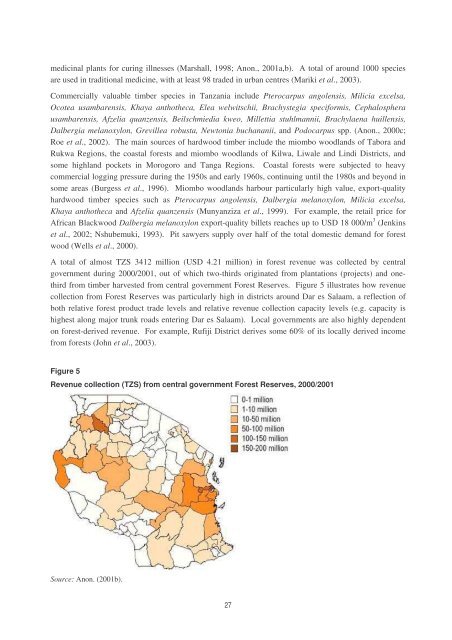Bridging the Gap: linking timber trade with infrastructural ...
Bridging the Gap: linking timber trade with infrastructural ...
Bridging the Gap: linking timber trade with infrastructural ...
You also want an ePaper? Increase the reach of your titles
YUMPU automatically turns print PDFs into web optimized ePapers that Google loves.
medicinal plants for curing illnesses (Marshall, 1998; Anon., 2001a,b). A total of around 1000 species<br />
are used in traditional medicine, <strong>with</strong> at least 98 <strong>trade</strong>d in urban centres (Mariki et al., 2003).<br />
Commercially valuable <strong>timber</strong> species in Tanzania include Pterocarpus angolensis, Milicia excelsa,<br />
Ocotea usambarensis, Khaya antho<strong>the</strong>ca, Elea welwitschii, Brachystegia speciformis, Cephalosphera<br />
usambarensis, Afzelia quanzensis, Beilschmiedia kweo, Millettia stuhlmannii, Brachylaena huillensis,<br />
Dalbergia melanoxylon, Grevillea robusta, Newtonia buchananii, and Podocarpus spp. (Anon., 2000c;<br />
Roe et al., 2002). The main sources of hardwood <strong>timber</strong> include <strong>the</strong> miombo woodlands of Tabora and<br />
Rukwa Regions, <strong>the</strong> coastal forests and miombo woodlands of Kilwa, Liwale and Lindi Districts, and<br />
some highland pockets in Morogoro and Tanga Regions. Coastal forests were subjected to heavy<br />
commercial logging pressure during <strong>the</strong> 1950s and early 1960s, continuing until <strong>the</strong> 1980s and beyond in<br />
some areas (Burgess et al., 1996). Miombo woodlands harbour particularly high value, export-quality<br />
hardwood <strong>timber</strong> species such as Pterocarpus angolensis, Dalbergia melanoxylon, Milicia excelsa,<br />
Khaya antho<strong>the</strong>ca and Afzelia quanzensis (Munyanziza et al., 1999). For example, <strong>the</strong> retail price for<br />
African Blackwood Dalbergia melanoxylon export-quality billets reaches up to USD 18 000/m 3 (Jenkins<br />
et al., 2002; Nshubemuki, 1993). Pit sawyers supply over half of <strong>the</strong> total domestic demand for forest<br />
wood (Wells et al., 2000).<br />
A total of almost TZS 3412 million (USD 4.21 million) in forest revenue was collected by central<br />
government during 2000/2001, out of which two-thirds originated from plantations (projects) and onethird<br />
from <strong>timber</strong> harvested from central government Forest Reserves. Figure 5 illustrates how revenue<br />
collection from Forest Reserves was particularly high in districts around Dar es Salaam, a reflection of<br />
both relative forest product <strong>trade</strong> levels and relative revenue collection capacity levels (e.g. capacity is<br />
highest along major trunk roads entering Dar es Salaam). Local governments are also highly dependent<br />
on forest-derived revenue. For example, Rufiji District derives some 60% of its locally derived income<br />
from forests (John et al., 2003).<br />
Figure 5<br />
Revenue collection (TZS) from central government Forest Reserves, 2000/2001<br />
Source: Anon. (2001b).<br />
27
















